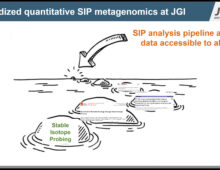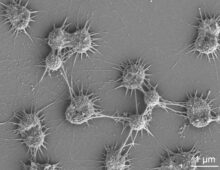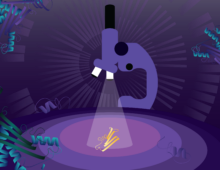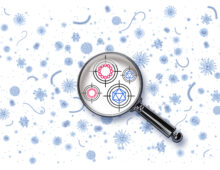Scientists have discovered flagella in an unexpected place: hot spring-dwelling bacteria from the phylum Chloroflexota. Research shows that flagella were lost in other forms of Chloroflexota that adapted to marine environments hundreds of millions of years ago.
Webinar: Metagenome quantitative SIP at JGI
The JGI offers metagenome quantitative stable isotope probing (Metagenome – qSIP) capabilities to investigate metabolic activity of metagenome-assembled genomes (MAGs).
JGIota: A Surprise for Chloroflexota — The First Flagella!
To understand how organisms adapt to extreme environments, Marike Palmer and Brian Hedlund study organisms living in hot springs. Hear how their recent work revealed more about the history of the Chloroflexota phylum and a new way of moving: a tail-like flagella.
For the Tiniest Archaea, A Genomic Switch of Friend or Foe
Recently, researchers used population genomics to find that while archaeal hitchhikers may often act as parasites, in other cases, they likely help their hosts.
Doubling Down on Known Protein Families
Through a novel approach detailed in Nature, a massive computational analysis of microbiome datasets focuses on unveiling protein functional diversity.
Natural Prodcast Episode 22 – Alison Narayan
In Natural Prodcast, Alison Narayan on “biocatalysis” her DNA synthesis project with the JGI to explore flavin monooxygenases, and figuring out how to make predictions about the functionality and chemical capabilities of enzymes.
The JGI announces 2024 awardees for our Community Science Program annual call
The JGI’s annual CSP call is focused on large-scale genomic science projects in sustainable biofuel and bioproducts production, global carbon and nutrient cycling, and biogeochemistry.
JGIota: A Tool to Find the Nomadic Genes that Help Microbes Adapt – geNomad
A quick snippet on Antonio Camargo and Simon Roux, a few of the JGI researchers behind software that finds plasmids and viruses within microbial genomes. As mobile genetic elements like viruses spread their DNA, they can affect how microbes cycle nutrients and adapt to climate change.
You Can Move, But You Can’t Hide
Researchers at the JGI developed geNomad, a tool to quickly and accurately identify mobile genetic elements like plasmids and viruses.
Natural Prodcast Episode 21 – Elizabeth Parkinson
Natural Prodcast guest Betsy Parkinson from Purdue on bacterial signaling molecules and regulation of biosynthetic pathways, student mental health, and getting kids interested in microbiology.






![A series of headshots: From left to right: [above] Olivia Ahern, Adriana Corales, Hugh Cross, Megan DeMarche, Joanne Emerson, Matthew Hudson, Megan Keller and Julia Kelliher; [below] Vassili Kouvelis, Seppe Kuehn, Tesfaye Mengiste, Egbert Schwartz, Hannah Schulman, Bram Stone and Jana Voriskova](https://jgi.doe.gov/wp-content/uploads/2023/10/IMAGE_2023CSP-220x170.jpeg)

